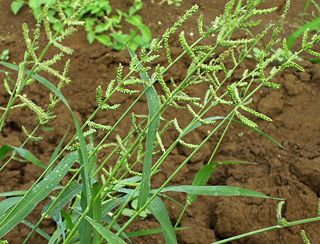
Millets (/ˈmɪlɪts/) are a group of highly variable small-seeded grasses, widely grown around the world as cereal crops or grains for fodder and human food.

Panicum miliaceum is a grain crop with many common names including proso millet, broomcorn millet, common millet,, hog millet, Kashfi milletred millet, and white millet,. Archeological evidence suggests that crop was first domesticated before 10,000 BCE in Northern China. The crop is extensively cultivated in China, India, Nepal, Russia, Ukraine, Belarus, the Middle East, Turkey, Romania, and the United States, where approximately half a million acres are grown each year. The crop is notable both for its extremely short lifespan, with some varieties producing grain only 60 days after planting, and its low water requirements producing grain more efficiently per unit of moisture than any other grain species tested. The name "proso millet" comes from the pan-Slavic general and generic name for millet Croatian: proso). Proso millet is a relative of foxtail millet, pearl millet, maize, and sorghum within the grass sub-family Panicoideae. While all of these crops utilize C4 photosynthesis, the others all employ the NADP-ME as their primary carbon shuttle pathway while the primary C4 carbon shuttle in proso millet is the NAD-ME pathway.

Oryza is a genus of plants in the grass family. It includes the major food crop rice. Members of the genus grow as tall, wetland grasses, growing to 1–2 m tall; the genus includes both annual and perennial species.

Panicum (panicgrass) is a large genus of about 450 species of grasses native throughout the tropical regions of the world, with a few species extending into the northern temperate zone. They are often large, annual or perennial grasses, growing to 1–3 m tall.

Foxtail millet is an annual grass grown for human food. It is the second-most widely planted species of millet, and the most important in East Asia. It has the longest history of cultivation among the millets, having been grown in India since antiquity. According to recent research, it was first domesticated in China around 6,000 BC. Other names for the species include dwarf setaria, foxtail bristle-grass, giant setaria, green foxtail, Italian millet, German millet, and Hungarian millet.

Echinochloa colona, commonly known as jungle rice, deccan grass, or Awnless barnyard grass, is a type of wild grass originating from tropical Asia. It was formerly classified as a species of Panicum. It is the wild ancestor of the cultivated cereal crop Echinochloa frumentacea, sawa millet. Some taxonomists treat the two taxa as one species, in which case the domesticated forms may also be referred to as E. colona.

Echinochloa crus-galli is a type of wild grass originating from tropical Asia that was formerly classified as a type of panicum grass. It is commonly known as cockspur, barnyard millet, Japanese millet, water grass, common barnyard grass, or simply "barnyard grass". This plant can grow to 60" in height and has long, flat leaves which are often purplish at the base. Most stems are upright, but some will spread out over the ground. Stems are flattened at the base. The seed heads are a distinctive feature, often purplish, with large millet-like seeds in crowded spikelets.
Echinochloa stagnina is a species of Echinochloa widespread in tropical Africa and Asia, with an invasive status in many Pacific islands.

Setaria is a widespread genus of plants in the grass family.

Panicum antidotale Retz. is a tall, coarse, woody perennial grass throughout the Himalaya and the Upper Gangetic Plain and specifically in various regions of the Indian state of Punjab and the Pakistan province of Punjab and the neighbouring areas of these regions. The plant has strong spreading rhizomes.

Paspalum scrobiculatum, commonly called Kodo millet or Koda millet,, is an annual grain that is grown primarily in India, and also in the Philippines, Indonesia, Vietnam, Thailand, and in West Africa from where it originated. It is grown as a minor crop in most of these areas, with the exception of the Deccan plateau in India where it is grown as a major food source. It is a very hardy crop that is drought tolerant and can survive on marginal soils where other crops may not survive, and can supply 450–900 kg of grain per hectare Kodo millet has large potential to provide nourishing food to subsistence farmers in Africa and elsewhere.

A grain is a small, hard, dry seed, with or without an attached hull or fruit layer, harvested for human or animal consumption. A grain crop is a grain-producing plant. The two main types of commercial grain crops are cereals and legumes.

Paniceae is a large tribe of the Panicoideae subfamily in the grasses (Poaceae), the only in the monotypic supertribe Panicodae. It includes roughly 1,500 species in 84 genera, primarily found in tropical and subtropical regions of the world. Paniceae includes species using either of the C4 and C3 photosynthetic pathways, as well as presumably intermediate species. Most of the millets are members of tribe Paniceae.
Cnaphalocrocis exigua is a moth in the Crambidae family. It was described by Arthur Gardiner Butler in 1879. It is found in Japan, China and on Fiji.
Nisaga simplex is a moth in the family Eupterotidae. It was described by Francis Walker in 1855. It is found in Bangladesh and India.













